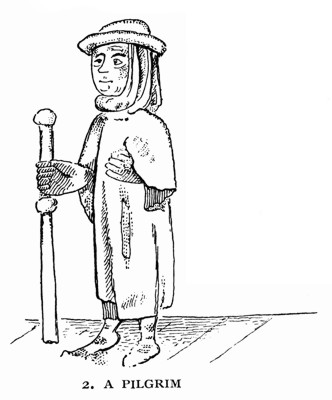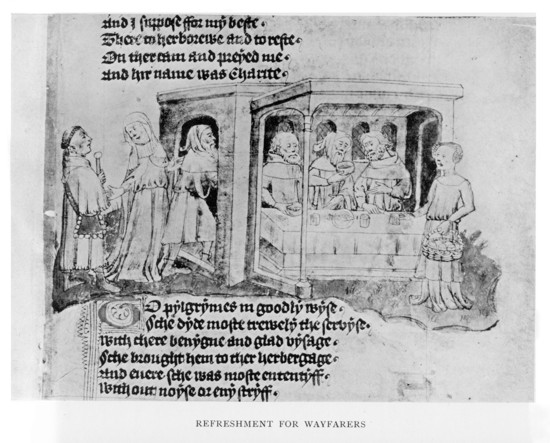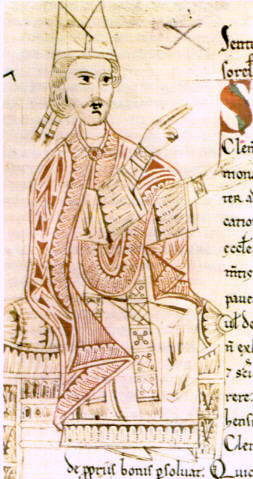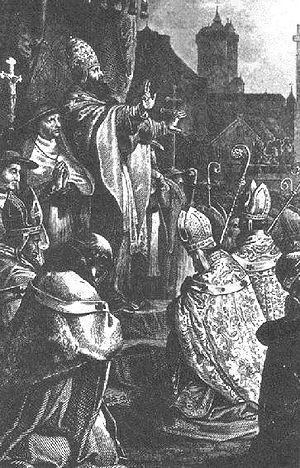The Great Boo-Hoo
Among the usual cris de coeur about Western Civilization are the Crusades, a series of unprovoked and dastardly aggressions against the Religion of Peace.™ These were, in this view, holy wars led by power-mad popes and fought by uncouth religious fanatics from an overpopulated and resource-poor backward Europe against the peaceful and enlightened Muslim culture, leaving it in ruins to this day.Depending upon which generation of occidentophobes we cite, these attacks are said to be due to evil Western capitalistic imperialism-colonialism or to evil Western Islamophobia. In either case, it is a projection of High Modern or Late Modern concerns onto a High Medieval milieu for which they are not exactly good fits. The eleventh and twelfth centuries were not exactly hot times for capitalism -- as Marx in fact knew. And is it really a phobia if someone has been attacking and raiding your lands for four hundred years and you at long last strike back?
Our modern view of the Crusades has been informed by Steven Runciman's influential text, A History of the Crusades. Most people today owe their view of oafish Frankish barbarians disrupting a suave and sophisticated Islamic culture to his work. Runciman greatly admired the Byzantine Empire, and regarded its destruction by the wayward "Fourth" Crusade as "the greatest crime committed against humanity." He delivered himself of this opinion only a decade or so after World War II, too; so it may be true what they say about academics.
Thomas F. Madden (2005) stressed the impact of Runciman's style and viewpoint:
Marxist historians accepted that the crusades were imperialistic, but they rejected the idea that they were motivated by idealism. Instead, they argued, the crusades were the result of the growth of medieval European population and a shortage of available resources. The crusades were simply surplus labor seeking new territories for themselves abroad. These ideas meshed well with the increasingly discredited nature of imperialism. Historians who were not themselves Marxist nevertheless accepted the premise that the crusades were the child of avarice and greed, because as imperialistic enterprises, they were clearly exploitative. The crusaders were thus shorn of any semblance of religious motivation.The irony is that these 19th century Marxist assumptions were then taught to the Arabs, who had themselves largely forgotten about the crusades, thus creating a whole new set of grievances by which to explain away the repressive backwardness of their regimes. This worked to the advantage of both the regimes and those who wished to overthrow them, and in the latter case suited the agendas of both the nationalists and the Islamists. Previously, the crusades had been a short-lived series of set-backs interrupting a thousand-year long assault on Christendom. Now they became the scapegoat for everything that had gone wrong. Islamic culture, they argued, had never recovered from this unprovoked invasion.
This view of the crusades was carved into stone with the publication of Sir Steven Runciman's three-volume History of the Crusades (1951-54). It is no exaggeration to say that Runciman single-handedly crafted the current popular concept of the crusades. The reasons for this are twofold. First, he was a learned man with a solid grasp of the chronicle sources. Second, and perhaps more important, he wrote beautifully. The picture of the crusades that Runciman painted owed much to current scholarship yet much more to Sir Walter Scott. Throughout his history Runciman portrayed the crusaders as simpletons or barbarians seeking salvation through the destruction of the sophisticated cultures of the east.
But even Runciman described his work as literature, not history. He wrote in the older tradition of Gibbon, all full of Grandeur and Sweep and Pronouncements, not in the modern tradition of dispassionate and careful examination of the documents of everyday life. Sometimes, if you want to know why people did what they did, it is useful to ask them. They're not always honest, but they may be more accurate than projecting modern concerns back onto them.
To take one example: the Europeans could hardly have mounted these campaigns if there had been a shortage of resources in Europe. It is precisely because of Europe's economic recovery from the dark age of Saracen, Viking, and Magyar assaults -- from the sacking of Rome and the burning of Genoa and the jihadi castles blocking commerce through the passes in the Alps -- that they were able to go out from Europe at all. Europe did not get rich from exploiting the East. The East was a continual drain on her resources, and as time went on it became more and more difficult to find volunteers to risk their lives and fortunes to venture out there.
Likewise, the argument that the muslim world is poor today because of the devastation wrought by the crusades: The crusades never touched most of that world, and in the centuries following the snuffing of the last crusader states, muslim armies took Otranto in Italy preparatory to a march on Rome, conquered the Balkans and Constantinople, and twice approached the Gates of Vienna to menace the center of Europe. The Grand Turk was a very real threat to Europe down to the 1600s.
But even before Runciman wrote his great work, historians were taking another look and were examining the assumptions behind the modern analysis. They found, for example, that far from being landless "second sons" out to strike it rich, most who went on the crusade were important and wealthy barons who mortgaged themselves to the hilt in order to afford the journey. (Remember, they had to pay their own way there and back.) This has been learned by a statistical analysis of the memorials that crusaders posted with their bishops prior to setting out. They did not expect for the most part to be coming back.
Our faith was strong in th’ Orient,
It ruled in all of Asia,
In Moorish lands and Africa.
But now for us these lands are gone
‘Twould even grieve the hardest stone...
-- Sebastian Brant, The Ship of Fools (1494)
The World in 1071
Okay, not the whole world maybe, but the world of the European-Near Eastern ecozone. On the eve of the crusades, that world looked like this.They [the muslims] were ultimately thrust back to the Pyrenees, but they continued to hold all Spain except the mountainous north-western corner. They held all Roman Africa, including Egypt, and all Syria. They dominated the whole Mediterranean west and east: held its islands, raided and left armed settlements even on the shores of Gaul and Italy. They spread mightily throughout Hither Asia, overwhelming the Persian realm. They were an increasing menace to Constantinople. Within a hundred years, a main part of the Roman world had fallen under the power of this new and strange force from the Desert.
Such a revolution had never been. No earlier attack had been so sudden, so violent or so permanently successful. Within a score of years from the first assault in 634 the Christian Levant had gone: Syria, the cradle of the Faith, and Egypt with Alexandria, the mighty Christian See. Within a lifetime half the wealth and nearly half the territory of the Christian Roman Empire was in the hands of Mohammedan masters and officials, and the mass of the population was becoming affected more and more by this new thing.
 |
| Normans liberating Sicily |
Within the House of Submission, the relative pax of the Arab Caliphate of Baghdad had shattered and Berber and Turkish warlords were now in charge with all the fervor of recent converts. The imperialist-colonialist Saljūqs held Persia and Mesopotamia. The Shi'ite Fatimids had come out of North Africa and now ruled in Egypt. When their left-behind Zirid governors had proven too independent back in Mahdi City and ditched the Shi'a for the Sunni, the Fatimids passed along the migrating tribes of the Beni Sulaym (who settled Cyrenaica in 1050) and the Beni Hilal (who colonized Tripolitania and Tunisia in 1051), changing these areas from Berber to Arab and driving the Berbers to the coastal cities. (To this day, "Libya" breaks naturally into these two parts.) The old Umayyad Caliphate of Cordoba had broken up into a score of independent taifas, Arab and Moor, and with it passed the Golden Age of Al-Andalus. Meanwhile, the al-murabitim (Almoravids), Sanhaja Berbers who had recently converted to Islam had flooded out of the Sahara, taken over the Emirate of Fez, and renamed it Marrakesh (Morocco). Shortly, some of the losing taifas in the muslim civil war will invite them to come into Spain to help out. They will, but will then refuse to turn control back over to their Moorish cousins and will make Spain an Almoravid colony.
 |
| Turkish warriors: Dude, who took my horse! |
 |
| A pilgrim with big hands |
 |
| Pilgrims stopping at an inn |
All that was needed was a trigger.
Disaster!
That trigger came on 26 August 1071, when the Turks crushed the Byzantine Roman army on the shore of Lake Van in Armenia: the Battle of Manzikert. While not militarily unrecoverable, the subsequent coup and disorder in the Empire allowed the frontier to collapse. Turkish colonists drove their flocks onto the Anatolian plateau -- and drove the peasants off the land. Anatolia had been the breadbasket of the Empire and its major source of manpower for the army. Without it, the Byzantines recoiled to the coast and the Balkans and could now look out across the Straits and see... "Turkey," in what had once been a Greek and Orthodox country¹ and the ancient land of the Cappadocian Fathers. The sites of three of the first four Ecumenical councils (Nicaea, Ephesus, Chalcedon) were now in muslim hands.After ten years of chaos, an actually competent emperor, Alexis I Comnenus (1081-1118), rallied the Byzantines and raised a mercenary army against the surrounding barbarians. And he wrote to the Pope begging for Help! He needed fighting men. Soon. Like now?
The Byzantines did not call on the West blithely. In their opinion, all of the West was Roman territory occupied temporarily by Frankish barbarians with pretensions. (And when the Normans freed Sicily and Southern Italy from the muslims, they also kicked out the remaining Byzantine garrisons.) Furthermore, although Christian, the Westerners were committed to various liturgical errors and possible doctrinal errors. Then there had been that matter of mutual excommunication about twenty years ago. A minor affair; not like it was the first time the two Sees had gotten in a snit with each other, and the assumption was that things would work out eventually. Both sides were trying to patch things up at this point.
 |
| Greg 7 |
Notes
1. Greek and Orthodox. Western and coastal Anatolia remained largely Greek and Orthodox down to the 1920s when, in the wake of WW1, following an unsuccessful Greek attempt to reclaim the region, it was ethnically cleansed by the Turks. They got rid of the Armenians too around the same time.
The Crusade That Didn't Happen
But Greg was a Reformer™, and the first step to quenching clerical abuses was to remove the kings from control of the clergy. So he issued a "Declaration of Independence" for the Church. From now on, only the Church could invest her bishops: no kings, emperors, or presidents need apply. Hank did not take the separation of Church from State well. (Oddly enough, the first thing the Protestant Reformers did, centuries later, was return their churches to secular control.) |
| Matilda moderates the agreement between Hank and Greg |
He approached as a barefoot penitent, knelt in the snow before the gates, and prayed admittance. Faced with this religious end run, Greg had no choice but to forgive him and lift the excommunication. He and Hank and Tilly had communion together. This cut the legs off the nobles' rebellion, which did not please them.
 |
| Matilda's castles |
Meanwhile, the whole mission to the east was put on the back burner.
Notes:
1. La gran contessa. In her own right. Christendom was the first civilization in which women could be equal players in the public square.
2. Matilda. Her prominent role in supporting the pope against the emperor has led some Late Moderns (can we say "Wikipedia"?) to suggest Greg and Tillie were getting it on. They can imagine no other reason, apparently, than pelvic ones; another example of how we project our own obsessions onto the past.
3. Canossa. Some people think that the Canossa episode demonstrates that the medieval Church dominated the secular powers. Yeah, right. That's the problem with superficial, stereotyped theories of history.
Let's Get Back on Track Here
 |
| Urban renewal |
They [the Turks] have completely destroyed some of God’s churches and they have converted others to the uses of their own cult. They ruin the altars with filth and defilement. They circumcise Christians and smear the blood from the circumcision over the altars or throw it into the baptismal fonts. They are pleased to kill others by cutting open their bellies, extracting the end of their intestines, and tying it to a stake. Then, with flogging, they drive their victims around the stake until, when their viscera have spilled out, they fall dead on the ground. They tie others, again, to stakes and shoot arrows at them; they seize others, stretch out their necks, and try to see whether they can cut off their heads with a single blow of a naked sword. And what shall I say about the shocking rape of women?This, and not promises of plunder, got folks riled up. Granted, he also urged the knights to stop fighting one another in Europe and turn their swords outward, but this was not the motive for the call. But he also shifted the focus from simply the liberation of Anatolia to the liberation of Jerusalem.
This was an age of relics and pilgrimages, and no place was more relic-heavy than Jerusalem, where Jesus himself had done his thing. Bad enough that the Arabs had taken it from the Byzantines four hundred years ago. At least they had allowed the pilgrims to come and go unmolested, for a fee. But the new situation was intolerable. It being a feudal age, the whole thing was cast in feudal terms. A vassal is pledged to assist his lord in recovering his lands, and everyone is vassal to Jesus, the lord of all. So how much more are we obligated to recover his lands!
"Whoever wishes to come after me must deny himself, take up his cross, and follow me." (Matt 16:24)Deus vult! the crowds shouted. God wills it!
Of course, Late Moderns wonder if anyone actually raised such a cry. They cannot imagine it really meant anything to the people of the era, since it means nothing to them today.
Pilgrim's Progress
So the whole thing became a pilgrimage! It was imagined as an errand of mercy and charity. Everyone taking part took a pilgrim's vow to visit the Holy Sepulcher. Because of the great expense and hardships of the journey, each pilgrim was granted a remission of sin -- just as any pilgrim to any shrine would. His lands were placed under the protection of the Church until his return. Additional vows dealt with fasting, abstinence from sex, particular devotions to be performed along the way, etc. A pilgrim's cross was sewn to the shoulder of his tunic.Armed pilgrimages were not a novelty, given the unsettled times. But this time around, the pilgrims were not only armed but trained in the use of arms. And there were a lot of them. Their oath was sworn to God, not to the pope or to any secular leader. In fact, none of the "cross-bearers" was actually in command. There was no hierarchy, no organization. It was a mass of several thousands of armed pilgrims heading more or less in the same direction with more or less the same purpose. Lords among the pilgrims could expect to command their own vassals, but no one else. They would elect a commander-in-chief as was customary, but the post was largely honorary and like any large feudal levy there would be much time spent negotiating issues of precedence and honor. No feudal lord worth his fief was going to take stinking orders from a peer! It was a very libertarian era, in a way.
Naturally, as among any large group of people, there were those who ran to the contrary. Knights on the run, robber barons, those out to get rich, those out to impress the troubadours. But they were the exceptions, not the rule. The arduousness of the journey weeded out all but the most serious and committed.Christendom was aroused. They were pumped! The Vikings and Magyars had been tamed. The cities had been rebuilt. New northern trade routes had replaced the lost Mediterranean ones. The moldboard plow, horse collar, and three-field rotation had unloosed an agricultural cornucopia from the heavy northern soils. As global warming set in, the growing season expanded and more and more land was brought under the plow. At Bologna, in the Holy Roman Empire, a new word was coined: "university." A second like it was formed in Paris, on the Left Bank, and about the time of this commentary, a third, at Oxford, was starting up. Formal charters would come later. Meanwhile, let's see if we can find copies of these Greek books the Latins mentioned. The Byzantines must have some.
After four hundred years of taking it on the chin, of seeing their heartlands seized, their cities raided and sacked, their churches burned and priests killed, and more recently (with the fervent Turks and Moroccans) a renewed intensity of persecution, Christendom was finally going to strike back! A wave of enthusiasm spread over their mountain fastnesses, their fortresses and towns. Those taking the vow included women, the aged, the infirm, clergy, and Spaniards, and some rhetoric was expended to discourage them from going. (Spaniards, in particular, were needed at home for their own crusade, and the others might sorta get in the way.) But since it was a pilgrimage and not a war, it was hard to forbid anyone from trying and the prohibitions were often honored in the breach. Still, you could wear the pilgrim's cross as one of "those that pray."
Except the Spaniards had picked up this weird idea of a "holy war" from the folks they had been fighting with to recover their country.
References
- Belloc, Hilaire. (1936) The Great Heresies, Ch. 4: The Great and Enduring Heresy of Mohammed
- Madden, Thomas F. (2006) The New Concise History of the Crusades (Rowman & Littlefield)
- McEvedy, Colin. The Penguin Atlas of Medieval History and The New Penguin Atlas of Medieval History. Maps from former are online here.







Your amateur history series are excellent. This one is a bit tougher though, isn't it? With Galileo, you (mostly) just have to get the documentary evidence out there. The revision of the pop-narrative (un-revision?) writes itself. With the Crusades, you have the additional and more serious problem of interpretation and paradigm-shift. Good luck going uphill on this one!
ReplyDeleteWonderful stuff! Now we're getting to where I've come across maybe 15%-20% of this stuff, up from maybe 5% in the prologue. Either way, I'm very grateful for having lacuna and details filled in.
ReplyDeleteOne can always find a scoundrel or 6 to discredit something, people being people and all. But that doesn't mean you can discount the motivations of the other people involved.
This series is excellent, and I am very much enjoying it. Thank you.
ReplyDeleteA nuance concerning the deportation of the Christians from Anatolia in 1923:
ReplyDeleteThis was not a unilateral expulsion, but half of a mutual deportation of religious minorities between Greece and Turkey, under the terms of the Treaty of Lausanne. The other half was the deportation of the Muslims from Greece. Political leaders of both nation-states claimed to be acting in the best interests of all concerned, as both new pollitical entities tried to throw off their legacies from the oppressive, fallen, multi-ethnic Ottoman empire.
The result was a lot of Greek-speaking Muslims trying to rebuild their shattered lives in the communities vacated by the Turkish-speaking Christians of Anatolia, while their Turkish-speaking Christian counterparts tried to rebuild their lives in the communities vacated by the Greek-speaking Muslims of Greece.
The reference is Twice a Stranger by Bruce Clark, Harvard University Press, 2006.
"Meanwhile, let's see if we can find copies of these Greek books the Latins mentioned. The Byzantines must have some."
ReplyDeletehttps://en.wikipedia.org/wiki/Transmission_of_the_Greek_Classics#Spain_and_Sicily
Most of that will take place after the time frame of this post.
DeleteWhat I find interesting is how we modern people want to see the Crusades as an *obvious* example of religion (whatever that is) being bad, yet we also want to see the Crusades as *really* motivated by non-religious goals such as money. I wonder if these interpretations can be reconciled, or even stem from a common foundation?
ReplyDeleteChristi pax,
Lucretius
Gratias ago optimas pro clarificatione de ... non tam sapienti ... Runciman.
ReplyDelete